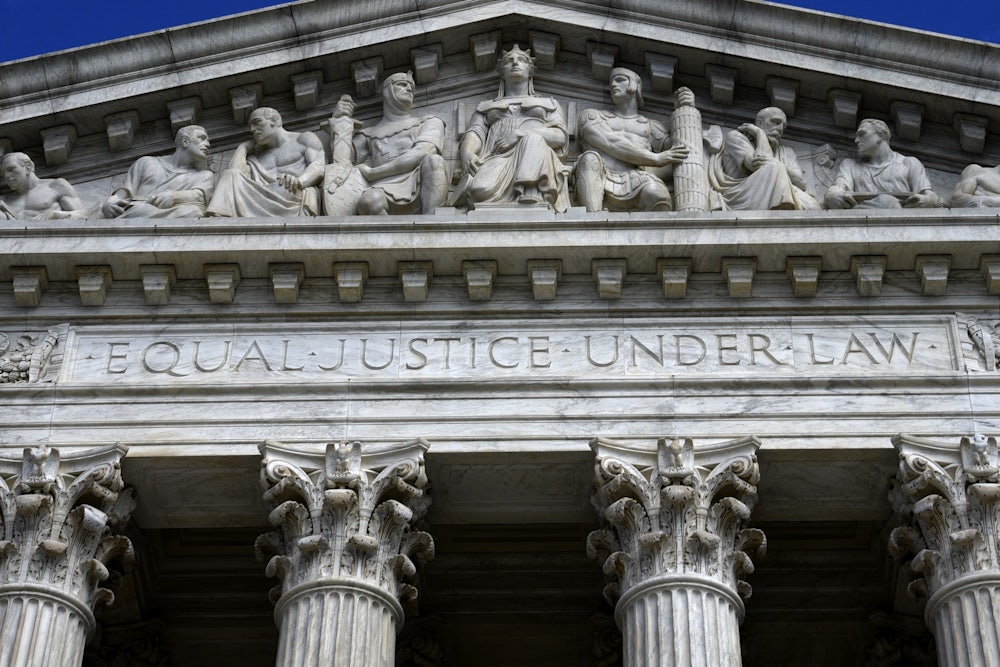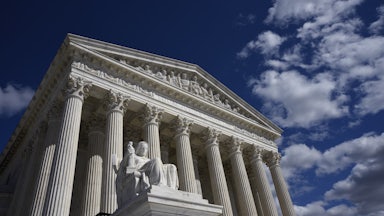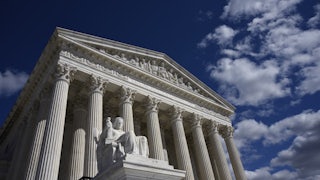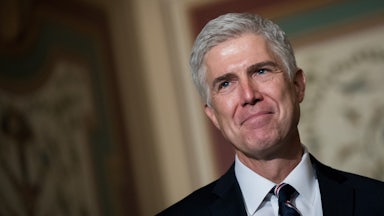The Supreme Court drove a stake through the heart of the independent state legislature theory on Tuesday, affirming that state courts have the constitutional power to review state laws that administer federal elections. The 6–3 ruling in Moore v. Harper bolsters state-level efforts to fight partisan gerrymandering and removes a potential source of instability ahead of the 2024 elections.
Under the Constitution, federal elections are largely run by the states. The elections clause says that “the times, places and manner of holding elections for senators and representatives, shall be prescribed in each state by the legislature thereof.” Proponents of the independent state legislature theory read that provision literally and exclusively. They argued that state lawmakers have exclusive discretion over those laws, and state courts and state constitutions cannot bind them.
The default assumption in American governance, of course, is that state legislatures are bound by checks and balances. “We are asked to decide whether the Elections Clause carves out an exception to this basic principle,” Chief Justice John Roberts wrote for the court. “We hold that it does not. The Elections Clause does not insulate state legislatures from the ordinary exercise of state judicial review.” His opinion was joined by Justices Brett Kavanaugh and Amy Coney Barrett and the court’s three liberal members.
Tuesday’s ruling is the second major election-related ruling that the court has handed down this month. Last week, the court ruled in Allen v. Milligan that Alabama had violated the Voting Rights Act of 1965 by not drawing a second majority-Black congressional district after the last census. In both cases, the justices rejected right-wing efforts to fundamentally reshape the nation’s election and voting laws. For now, at least, the status quo reigns supreme.
At issue in Moore was the drawing of North Carolina’s congressional districts. The state’s legislative maps are among the most gerrymandered in the nation. A Republican supermajority in the state legislature spent the last decade crafting laws to tilt North Carolina’s electoral system in their favor. They are not particularly ashamed of it either.
“I propose that we draw the maps to give a partisan advantage to 10 Republicans and three Democrats, because I do not believe it’s possible to draw a map with eleven Republicans and two Democrats,” one state lawmaker famously said in 2016, referring to North Carolina’s congressional districts. In a democracy, voters are supposed to pick their lawmakers. In North Carolina, it’s often the other way around.
Partisan gerrymandering—and the warping effect it can have on American democracy—is a vexing issue in the republic. For a time, federal judges sought to restrain this impulse by state legislatures, especially after the Republicans’ wave victory in the 2010 midterms turbocharged the process. But the Supreme Court closed that door in the 2019 case Rucho v. Common Cause, where the justices ruled 5–4 that federal courts could no longer hear partisan gerrymandering cases. That left state constitutions and state courts as the only viable alternative for reform.
North Carolina lawmakers redrew their maps after receiving an additional congressional district in the 2020 census, leaving them largely favorable toward Republican candidates. A group of voters and voting rights groups quickly challenged the new map in state court. They argued that the map’s severe partisan tilt violated North Carolina’s constitution. While the trial court agreed that the map was designed to maximize GOP electoral advantages, it ruled that the case was nonjusticiable under the state constitution, meaning that courts had no grounds to hear it.
On appeal, however, the North Carolina Supreme Court rejected that argument and ruled that the maps “substantially infringe upon plaintiffs’ fundamental right to equal voting power.” It also rejected the state legislature’s attempt to invoke the independent state legislature theory and ordered the lower court to draw new maps for the 2022 midterm elections. Under those new maps, Democrats and Republicans each won seven of the state’s 14 congressional seats last fall.
The Supreme Court allowed the new maps to go into effect but also agreed to review the case to determine if the independent state legislature theory’s reading of the elections clause was correct. Roberts rejected it outright, both as a matter of constitutional structure and as a matter of precedent. He noted that courts in multiple states had exercised judicial review in the period between independence and the drafting of the Constitution, and that the Framers were not only well aware of this trend but had actively embraced it.
“The argument advanced by the defendants and the dissent also does not account for the Framers’ understanding that when legislatures make laws, they are bound by the provisions of the very documents that give them life,” Roberts wrote. “Legislatures, the Framers recognized, ‘are the mere creatures of the state constitutions, and cannot be greater than their creators.’”
Roberts also noted that a series of the court’s own precedents, including a 2015 case that upheld Arizona’s independent redistricting commission, “each rejected the contention that the Elections Clause vests state legislatures with exclusive and independent authority when setting the rules governing federal elections.” The chief justice spoke with some personal experience on this matter: He had argued the opposite position in a lengthy dissent from the Arizona case at that time.
Complicating matters was a change in the North Carolina Supreme Court’s composition since the high court took up the case last spring. After Republican-backed judges won a majority of the court’s seats in last fall’s midterms, they reheard the underlying case and reversed their prior decision in April. That forced the Supreme Court to now consider whether the case was moot.
Justice Clarence Thomas, who dissented from Tuesday’s ruling along with Justices Samuel Alito and Neil Gorsuch, argued that the case should be dismissed. “This is a straightforward case of mootness,” Thomas wrote. “The federal defense no longer makes any difference to this case—whether we agree with the defense, disagree with it, or say nothing at all, the final judgment in this litigation will be exactly the same.” (Thomas and Gorsuch also disagreed with the majority on the merits, while Alito declined to go any further after concluding it was moot.)
Writing for the majority, Roberts instead concluded that the court could still reach the merits. Because the state Supreme Court had not overturned the portion of the judgment that blocked the state legislature’s original gerrymandered maps, he reasoned, there was still a live controversy before the justices to consider. “The defendants did not ask the North Carolina Supreme Court to vacate that judgment, that court did not purport to do so, and the defendants now concede that they remain bound by it,” he noted.
Tuesday’s ruling is significant in two ways. First, it affirms that state courts have the ability to intervene in partisan gerrymandering cases. Those courts still might not have the power to do so, depending on how their respective state constitutions are written, of course. But by rejecting the independent state legislature theory outright, the Supreme Court has ensured that where state courts do have the power to address partisan gerrymandering, the federal Constitution won’t stand in their way. (Well, maybe—we’ll come back to that in a second.)
Second, and perhaps more urgently, the court’s decision removes a potential source of legal and constitutional chaos in next year’s presidential election. Election-law experts have long warned that, in its most radical form, the theory could allow state legislatures to overturn election results after the fact on specious grounds, as former President Donald Trump and his allies sought in 2020. If the court had dismissed the case as moot, the justices may have been asked to decide it in the intense heat of a possible disputed presidential election next year.
The only caveat in the court’s ruling is that Roberts imposed a guardrail of sorts on state supreme courts in future cases. He suggested, without going into any detail, that the Supreme Court may yet constrain that authority down the road. “State courts retain the authority to apply state constitutional restraints when legislatures act under the power conferred upon them by the Elections Clause,” he wrote. “But federal courts must not abandon their own duty to exercise judicial review.”
Roberts cautioned that state courts “may not so exceed the bounds of ordinary judicial review as to unconstitutionally intrude upon the role specifically reserved to state legislatures” by the clause. What does that mean? Who knows? The chief justice did not elaborate any further. His warning is almost thrown in as an aside at the very end, like some judicial version of a Marvel post-credits scene. For now, what matters is the unexpected string of victories that voting rights advocates have achieved at the Supreme Court this month. To paraphrase a former vice president, the independent state legislature theory is dead, and Section 2 of the Voting Rights Act is alive.










